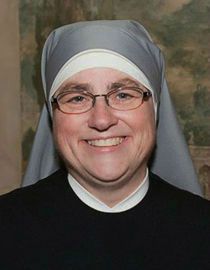After participating in the launch of the National Eucharistic Pilgrimage in New Haven, Connecticut, I had the grace of rejoining it in New York.
Although a New York native and frequent visitor to the Big Apple, the pilgrimage introduced me to areas of the city I had never seen or experienced.
Over the course of four days, Jesus in the Blessed Sacrament visited many parishes, schools, healthcare institutions and even Central Park. He found himself at home among the most devout and made himself known even among those who do not know him.
We Little Sisters were blessed to participate in several pilgrimage events, each of which showcased a unique neighborhood or aspect of New York.
One day, we participated in stops at a Catholic nursing home and high school in the Bronx. The next day, we attended Mass at the Mother Cabrini Shrine in upper Manhattan and then went to a prayer vigil at St. Vincent Ferrer church in the Upper East Side, the city’s wealthiest neighborhood.
On Trinity Sunday, we attended Mass at St. Patrick’s Cathedral and then climbed up on the pedestrian level of the Brooklyn Bridge to witness the handover of the Blessed Sacrament from the Archdiocese of New York to the Diocese of Brooklyn.
Finally, after processing along some the borough’s oldest streets, we prayed at Our Lady of Lebanon Maronite Cathedral.
That our participation in this portion of the Eucharistic Pilgrimage began in a nursing home seemed so natural to us. We felt right at home as we knelt among the wheelchairs in the chapel of St. Patrick’s Home, thanking God, who never forgets the poor and lowly, that the pilgrimage organizers had not forgotten them either.
Similar sentiments filled our hearts as we prayed with people of all ages at Cardinal Hayes High School in the South Bronx later that day. The setting and music were modest, but the preaching and prayers were lively, heartfelt and very real.
Surely, Jesus was pleased to be among those who were so aware of their need for him.
Like the evening at Cardinal Hayes, the program at St. Frances Cabrini Shrine the next day was bilingual and the congregation predominantly Spanish-speaking.
The Shrine is home to Cabrini Immigrant Services, which offers much-needed assistance to newcomers from all over the world.
Once again, it was touching to see Jesus at home among simple people seeking refuge and a second chance in life.
Later, we found ourselves in one of the most beautiful neo-gothic churches I have ever seen. We enjoyed reflections drawn from Dominican saints and listened to Latin motets exquisitely sung by a schola clothed in crisp cassocks and surplices.
As simple as the previous evening had been, this night’s program reflected the architectural, artistic and musical richness of the church.
Sunday’s celebration at St. Patrick’s Cathedral also showcased the church’s spiritual and artistic riches.
At the conclusion of Mass, Cardinal Timothy Dolan offered Benediction outdoors on the front steps of the Cathedral and then hundreds of people followed the Blessed Sacrament in procession through Manhattan.
Jesus was truly among us!
As the nearly 15-mile procession reached its climax on the Brooklyn Bridge, hundreds of tourists walked around, seemingly oblivious to what was happening but some stood respectfully as the throng of faithful advanced across the bridge, singing and praying in English, Spanish and Latin as cars sped in both directions on the bridge below.
Once again, I was struck by Jesus’ humility in allowing himself to be carried among his people in the ordinariness and grittiness of city life.
Our pilgrimage afternoon concluded in the Maronite Cathedral of Our Lady of Lebanon.
I later learned this church had been built in the mid-1800s by a Christian group tracing their lineage back to the original pilgrims who landed in Plymouth in 1620.
By the early 20th century, the group’s numbers were diminishing, while the number of eastern-rite Syrians and Lebanese in New York was growing. The church of the pilgrims was remodeled and reconsecrated, becoming Our Lady of Lebanon Maronite church.
As we knelt in the Maronite Cathedral singing “O Sacrament Most Holy, Tantum Ergo” and finally, “Holy God We Praise Thy Name,” it struck me that we had sung the same hymns and witnessed the same tradition of Benediction of the Blessed Sacrament along each stop of our pilgrimage.
Regardless of the great diversity we witnessed in New York, there were elements common to each celebration.
How beautiful it is to realize that in the midst of such great diversity, there is profound unity in the Body and Blood of Christ.
Sr. Constance Veit is the communications director for the Little Sisters of the Poor in the United States and an occupational therapist.

Sr. Constance Veit
